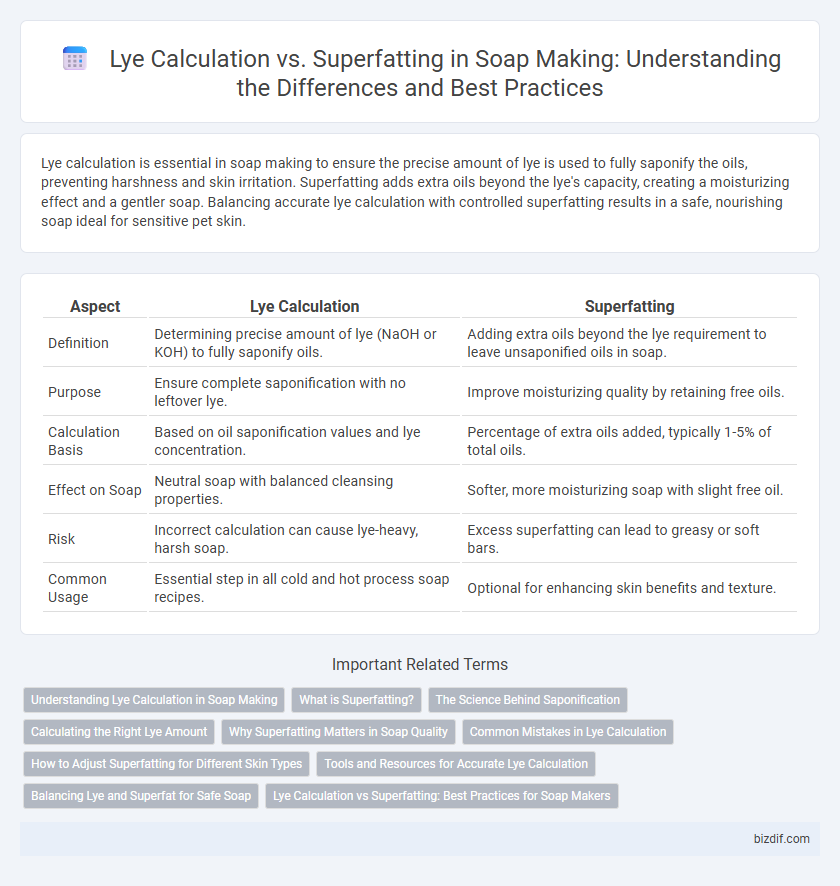Lye calculation is essential in soap making to ensure the precise amount of lye is used to fully saponify the oils, preventing harshness and skin irritation. Superfatting adds extra oils beyond the lye's capacity, creating a moisturizing effect and a gentler soap. Balancing accurate lye calculation with controlled superfatting results in a safe, nourishing soap ideal for sensitive pet skin.
Table of Comparison
| Aspect | Lye Calculation | Superfatting |
|---|---|---|
| Definition | Determining precise amount of lye (NaOH or KOH) to fully saponify oils. | Adding extra oils beyond the lye requirement to leave unsaponified oils in soap. |
| Purpose | Ensure complete saponification with no leftover lye. | Improve moisturizing quality by retaining free oils. |
| Calculation Basis | Based on oil saponification values and lye concentration. | Percentage of extra oils added, typically 1-5% of total oils. |
| Effect on Soap | Neutral soap with balanced cleansing properties. | Softer, more moisturizing soap with slight free oil. |
| Risk | Incorrect calculation can cause lye-heavy, harsh soap. | Excess superfatting can lead to greasy or soft bars. |
| Common Usage | Essential step in all cold and hot process soap recipes. | Optional for enhancing skin benefits and texture. |
Understanding Lye Calculation in Soap Making
Lye calculation in soap making determines the precise amount of sodium hydroxide required to fully saponify oils and fats, ensuring no excess lye remains in the final product. Accurate lye calculation is essential for balancing the chemical reaction and producing a safe, effective soap, while superfatting involves intentionally adding extra oils to create a moisturizing effect. Mastering lye calculation helps prevent soap from being harsh or overly alkaline, optimizing the quality and skin-friendliness of handmade soap bars.
What is Superfatting?
Superfatting is the process of intentionally adding extra oils or fats beyond the amount needed to fully react with lye, ensuring some oils remain unreacted for moisturizing properties. This technique enhances the soap's gentleness and conditioning effects by preventing excess lye from drying out the skin. Accurate lye calculation is crucial to balance superfatting, maintaining soap quality while maximizing skin benefits.
The Science Behind Saponification
Lye calculation is critical in soap making to ensure complete saponification, where sodium hydroxide (lye) reacts with fats or oils to form soap and glycerin. Superfatting involves adding extra oils beyond the lye's capacity, leaving some oils unsaponified to enhance moisturizing properties and prevent harshness. Precise control of lye quantity and superfat percentage determines soap hardness, cleansing ability, and skin conditioning, reflecting the underlying chemistry of the saponification process.
Calculating the Right Lye Amount
Calculating the right lye amount in soap making is essential for achieving a balanced saponification reaction that avoids harshness or excess oiliness. Precise lye calculation involves using accurate oil weights and their saponification values, ensuring the lye quantity completely reacts without leaving unreacted sodium hydroxide. Superfatting, which intentionally reduces lye to leave extra oils in the soap, requires careful adjustment of the lye calculation to maintain effective cleansing while enhancing moisturizing properties.
Why Superfatting Matters in Soap Quality
Precise lye calculation ensures complete saponification but may leave soap feeling harsh if overly exact. Superfatting introduces extra oils beyond the necessary amount of lye, enhancing moisturizing properties and preventing dryness on the skin. The balance between thorough lye calculation and adequate superfatting is critical for producing high-quality soap with optimal gentleness and lather.
Common Mistakes in Lye Calculation
Common mistakes in lye calculation during soap making include inaccurate measurements of sodium hydroxide (NaOH) or water, which can lead to overly harsh or soft soap. Misjudging the amount of superfat--excess oil left unsaponified--often results from incorrect lye discount percentages, causing either greasy soap or reduced cleansing properties. Precise lye calculation ensures the proper chemical balance to achieve a safe and effective final product.
How to Adjust Superfatting for Different Skin Types
Adjust superfatting levels in soap making by considering skin types: increase superfatting to 8-10% for dry or sensitive skin to provide extra moisturizing oils, while oily skin benefits from lower superfatting around 3-5% to avoid excess greasiness. Precise lye calculation is essential to ensure complete saponification, preventing harshness or residual lye that can irritate sensitive skin. Balancing lye quantity with adjusted superfat helps create tailored soaps that cleanse effectively while maintaining skin health.
Tools and Resources for Accurate Lye Calculation
Precise lye calculation is essential for safe and effective soap making, requiring specialized tools like digital scales, lye calculators, and reliable software such as SoapCalc or Mendrulandia. These resources help determine the exact sodium hydroxide needed, accounting for oil types and desired superfat levels to prevent lye excess and skin irritation. Using accurate lye calculators ensures optimal superfatting, which enhances soap moisturizing properties while maintaining proper chemical balance.
Balancing Lye and Superfat for Safe Soap
Accurate lye calculation ensures the complete saponification of oils, preventing the presence of unreacted alkali that can irritate skin. Superfatting introduces a controlled excess of oils, providing moisturizing benefits and a safer, gentler bar. Balancing precise lye amounts with appropriate superfat levels enhances soap safety by eliminating harshness while maintaining cleansing effectiveness.
Lye Calculation vs Superfatting: Best Practices for Soap Makers
Accurate lye calculation ensures the correct amount of sodium hydroxide to fully saponify oils, preventing harsh or unsafe soap. Superfatting involves intentionally adding extra oils beyond the calculated lye requirement, enhancing moisturizing properties and reducing skin irritation. Balancing precise lye calculation with appropriate superfatting levels is essential for producing high-quality, skin-friendly soap with optimal hardness and cleansing power.
Lye Calculation vs Superfatting Infographic

 bizdif.com
bizdif.com